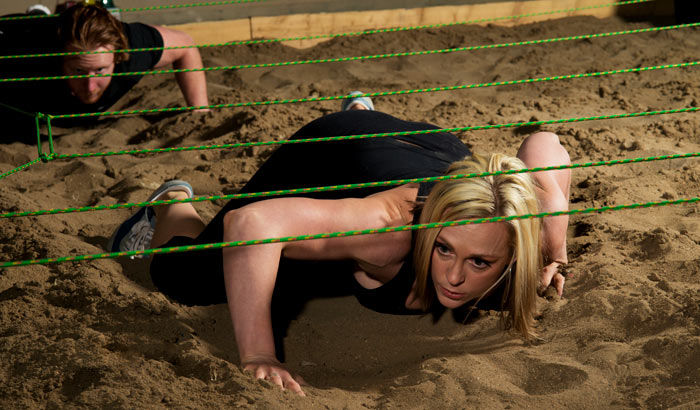
Since the 2009 debut of the Warrior Dash running series, the recreational sport genre of mud runs and obstacle course races has exploded. Races ranging from 5k to 10k are popping up everywhere and there are no signs of this kind of weekend activity slowing down anytime soon. Mud runs come in a variety of distances and difficulties, but all of them have two things in common: distance running separated by some type of obstacle every quarter to one-half mile, and mud. Lots and lots of mud.
Mud runs offer a combination of balance of strength and endurance, mixing the natural movement of walking/running with whole-body movements requiring skill to navigate and complete each one of the obstacles with ease, or at least with no fear. Leap through walls of fire, crawl face down in mud, climb and hurl yourself over a tall barricade—each of these are obstacles you should be prepared to tackle. Mud runs offer not only a physical challenge, but a psychological one as well.
You’ve thought about it. You’ve seen your friends post mud-run pictures on social media. Now it’s your turn to get in on the fun and start training for your first obstacle race. There are no medals. There are no winners. There are, however, bragging rights and the deep sense of accomplishment and empowerment that comes when you cross the finish line. Oh, and mud. Lots and lots of mud.
Mud Run Training Program
To best mimic the patterns of a mud run, this training program alternates treadmill running with exercises performed for one minute that focus on the skills needed to conquer the obstacles: pushing, crawling, pulling, balance and jumping.
Perform the following training program two days a week for six weeks. If time permits, add a third day of training and complete the workout again or supplement the program with another day of walking/running, outdoors if possible.
Week 1-2: Complete the workout once per week.
Week 3-6: Complete the workout two times per week.

*DB = Dumbbell
The Exercises
Pushing: DB Squat to DB Shoulder Press
Stand with your feet shoulder-width apart, holding a dumbbell in each hand at shoulder height. Lower down into a squat position then rise back up to standing and push the dumbbells overhead into a shoulder press.
Crawling: Bear Crawl
Begin on all fours on the floor, shoulders over the wrists and hips over the knees. Lift your knees slightly off the ground and balance on your toes. Keeping the hips low, begin traveling by simultaneously moving one hand and the opposite knee forward.
Pulling: Inverted Row
Lie on your back under a fixed horizontal bar (barbell rack or smith machine) and grasp the bar with a wide overhand grip. Keeping the body straight, pull the body up to the bar and lower back down until the arms are extended. If a horizontal bar is not available, other pull-up options include the assisted pull-up machine or TRX rows.
Balance: Bird-dog
Begin on all fours on the floor, shoulders over the wrists and hips over the knees. Engage your core and concentrate on keeping a neutral spine. Raise the right arm and the left leg parallel to the floor. Hold for a few seconds and then return back to the starting position. Switch sides, raising the left arm and right leg parallel to the floor.
Jumping: Split Jumps
Begin in a split-stance position, with one foot forward and the other foot back. Lower down into a lunge position and then immediately jump upward and switch legs, landing with the opposite foot forward. Another option is to jump upward without switching the legs, always landing on the front leg for 30 seconds before switching to the other leg.
Total-body Finisher: Belly Drop Burpee + Long Jump
Stand with your feet hip-width apart and your arms down by your sides. Lower down into a squat position and place both hands on the floor. Walk or jump your feet back and drop immediately to your belly. Push your body back up and walk or jump your feet back up to your hands. Instead of jumping up, jump forward landing softly into the legs and feet. If you have space, continue with another rep moving forward. If space is limited, after performing the long jump, turn around and repeat the exercise.




 by
by 



 by
by